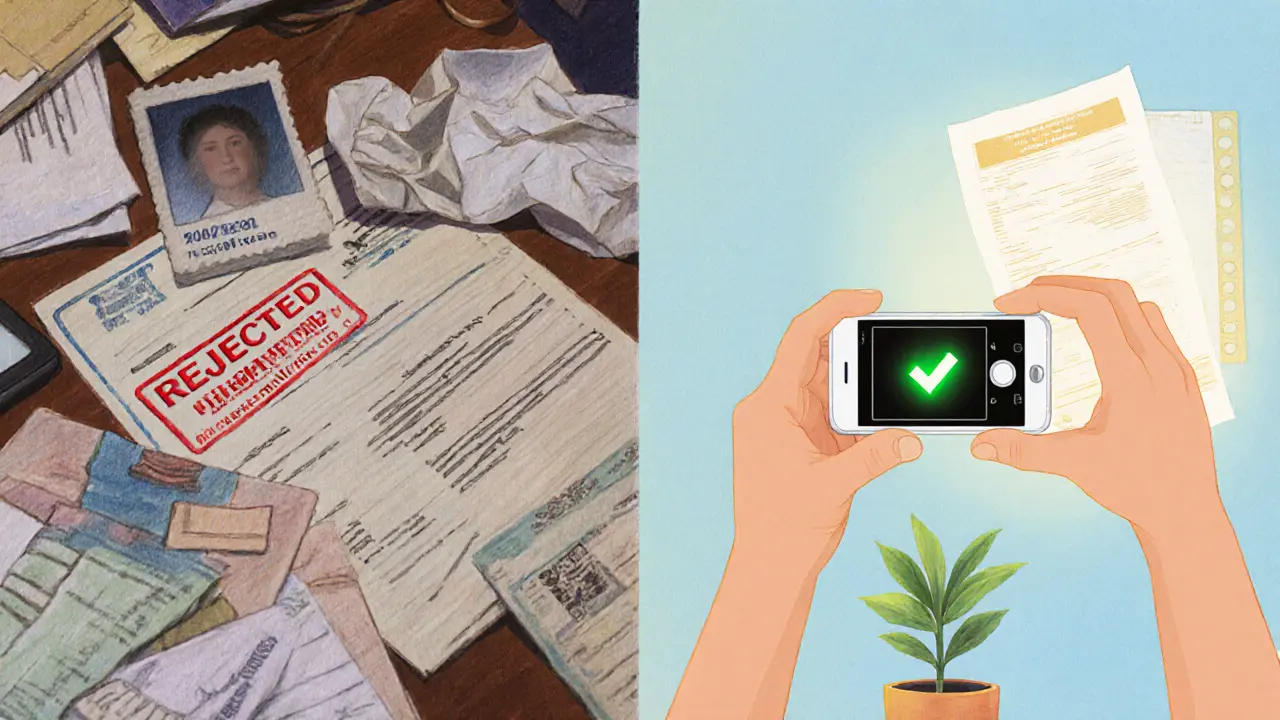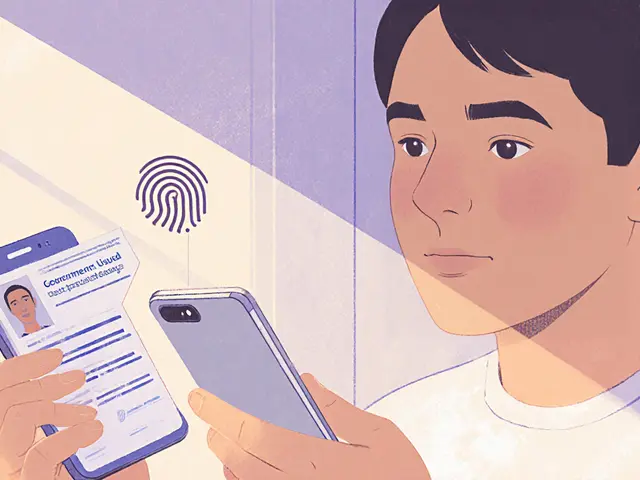What Is KYC in Cryptocurrency? A Clear Guide to Identity Verification in Crypto

KYC Rejection Diagnosis Tool
Why Was Your KYC Rejected?
Enter the reason for your rejection to get specific guidance on how to fix it.
How to Fix Your KYC Rejection
When you sign up for a crypto exchange like Coinbase or Binance, you’re asked to upload a photo of your ID, take a selfie, and confirm your address. It feels intrusive. It feels slow. But here’s the truth: KYC in cryptocurrency isn’t optional anymore-it’s the backbone of how crypto connects to the real financial world.
What Exactly Is KYC in Crypto?
KYC stands for Know Your Customer. It’s a process where crypto platforms verify your identity before letting you trade, deposit, or withdraw money. This isn’t just a policy-it’s a legal requirement in most countries. The goal? To stop criminals from using crypto to launder money, fund terrorism, or run scams. KYC started in traditional banking. The U.S. Bank Secrecy Act of 1970 forced banks to confirm who their customers were. After 9/11, the USA PATRIOT Act made it even stricter. By 2013, the U.S. Treasury’s FinCEN ruled that crypto exchanges were money transmitters-meaning they had to follow the same rules as banks. Today, 98% of the top 50 crypto exchanges require KYC. If you’re using a major platform, you’re already in the system.What Information Do You Need to Provide?
It’s not just your name. KYC in crypto demands real, verifiable data:- Your full legal name (exactly as it appears on your ID)
- Date of birth
- Current residential address
- Government-issued photo ID (passport, driver’s license, national ID card)
- Proof of address (a recent utility bill or bank statement)
- Proof of income or source of funds
- Documents showing who owns a company (if you’re trading as a business)
How Does the Process Work Step by Step?
Here’s what actually happens when you start KYC on a crypto exchange:- Identification: You enter your name, email, and date of birth. Simple.
- Document Upload: You take a photo of your ID using your phone. The app checks if it’s clear, not expired, and matches the country’s format.
- Liveness Check: You’re asked to blink, turn your head, or smile. The system uses AI to confirm you’re a real person, not a photo or video.
- Address Verification: You upload a bill or bank statement with your name and current address. Some platforms auto-check this with public databases.
- Risk Scoring: The system analyzes your info and behavior. Did you use a VPN? Are you from a high-risk country? Does your ID look altered? You get a risk score that determines your trading limits.

Why Do Some People Hate KYC?
It’s not just about privacy. People complain about:- Long wait times: 24 to 72 hours for approval is common during busy periods.
- Rejected documents: A tiny shadow on your ID can get you turned down-even if it looks fine to you.
- Overly strict rules: Some platforms ask for proof of income just to trade $500.
No-KYC Crypto: What’s the Trade-Off?
There are platforms that don’t require KYC. Decentralized exchanges like Uniswap and PancakeSwap let you swap tokens without ever giving your name. Bitcoin ATMs in the U.S. often allow under $900 without ID. But here’s the catch:- You can’t buy crypto with a bank card or wire transfer on no-KYC platforms.
- You can’t cash out to your bank account without KYC.
- Most no-KYC services are shut down by regulators. Since 2020, 45% of anonymous crypto on-ramps have disappeared.
- If you’re a U.S. taxpayer, the IRS will soon require 1099-DA forms for all taxable crypto transactions-meaning even decentralized trades will eventually need KYC.
Who Benefits From KYC?
Not just regulators. You do. - In 2022, a user on Kraken had their account hacked. Because KYC verified their identity, Kraken was able to freeze the stolen funds and return $12,000. That’s real protection. - Institutional investors (hedge funds, family offices) won’t touch any exchange without KYC. 87% of them only use verified platforms. - If you’re buying crypto for long-term holding, KYC gives you legal standing. If the IRS comes knocking, you can prove you bought it legally. Even experts who criticize KYC admit it’s necessary. Former FinCEN Director James H. Freis says KYC helped identify 83% of transactions involving sanctioned entities. That’s not perfect-but it’s the best tool we have.
What’s Changing in 2025?
Regulation is tightening. The EU’s MiCA law (effective June 2024) requires all crypto service providers in Europe to have full KYC. The U.S. is moving toward similar rules. By 2026, the IRS will require every taxable crypto transaction to be tied to a verified identity. New tech is emerging to make KYC less invasive:- Decentralized identity: Projects like Microsoft’s ION let you prove who you are without handing your data to a company. You control the credentials.
- Verifiable credentials: Think of it like a digital passport you can show to exchanges without revealing your full birth certificate.
Should You Use a KYC Exchange?
If you’re:- Buying crypto with a credit card or bank transfer
- Trading more than $1,000 a month
- Planning to cash out to your bank account
- Investing for the long term
How to Pass KYC Without Rejection
Follow these tips if you’ve been rejected before:- Use your phone’s camera-not a desktop webcam.
- Take the photo in natural light. No flash. No shadows.
- Make sure your ID is current (less than 5 years old).
- Spell your name exactly as it appears on your government document.
- Use the exchange’s official app. Mobile apps have better image processing.
- Don’t use a VPN during verification. It triggers fraud flags.
Is KYC mandatory for all crypto exchanges?
Most major centralized exchanges require KYC, especially if you want to buy crypto with fiat currency or withdraw to a bank account. Decentralized exchanges (DEXs) like Uniswap don’t require KYC, but they don’t allow fiat on-ramps. As of 2025, nearly all platforms that connect crypto to the traditional financial system are legally required to perform KYC.
Can I trade crypto without KYC?
You can trade crypto-to-crypto on decentralized exchanges without KYC. But if you want to buy Bitcoin with USD, sell Ethereum for euros, or withdraw to your bank, you’ll need to go through KYC. No-KYC options are shrinking fast due to global regulations like MiCA and U.S. IRS rules.
Why does KYC take so long?
KYC verification can take 24-72 hours because exchanges manually review documents for fraud, especially during high-volume periods. AI handles most of it, but complex cases-like corporate accounts or mismatched names-require human review. Some platforms, like Coinbase, offer 24/7 chat support to speed things up.
What happens if my KYC is rejected?
If your KYC is rejected, you’ll get an email or in-app message explaining why. Common reasons include blurry ID photos, expired documents, or name mismatches. You can usually reapply after fixing the issue. Don’t submit multiple times in a row-wait at least 24 hours.
Is my personal data safe with KYC?
Reputable exchanges store your data securely using encryption and comply with GDPR and other privacy laws. But no system is 100% hack-proof. If you’re concerned, use exchanges with strong security records (like Coinbase or Kraken) and enable two-factor authentication. New technologies like decentralized identity aim to give users more control over their data in the future.
Will KYC ever go away in crypto?
No. KYC is here to stay. Regulators worldwide agree it’s essential to prevent financial crime. While the way KYC works may change-becoming more privacy-focused with decentralized identity-it won’t disappear. Even decentralized protocols are being pressured to comply with global rules. The future is not no-KYC-it’s smarter, more secure KYC.







KYC is such a pain in the ass. I just wanted to buy some BTC and now I’m uploading my driver’s license like I’m applying for a mortgage. Why does my face need to be in their database forever?
Wow. So we’re all criminals until proven innocent now? Great. Just great.
Think about it this way: the internet was once a wild frontier where anyone could say anything, do anything, and vanish into the ether. Then came regulation, then came accountability, then came the slow, grinding realization that freedom without responsibility is just chaos with Wi-Fi. KYC isn’t the enemy-it’s the price of admission to a financial system that no longer tolerates anonymity as a shield for fraud. We traded the myth of total privacy for the reality of functional trust. And honestly? It’s worth it. The alternative isn’t freedom-it’s a dumpster fire of untraceable scams and rug pulls that leave grandma’s retirement fund in the hands of a Nigerian prince with a Discord server.
Every time you complain about KYC, remember: the only people who hate it are the ones who want to move money without leaving a trail. And that’s not crypto freedom. That’s criminal convenience dressed up as ideology.
Decentralized identity? That’s the future. Not no-KYC. No-KYC is dead. The future is you holding your own verified credentials, encrypted, blockchain-backed, and only shared when you say so-not handed over like a birthday card to a corporation that’ll sell your data to the highest bidder. That’s the real win. Not avoiding verification. Owning it.
Y’all are overthinking this 😊 I did my KYC in 12 mins and got verified! Just use good lighting and don’t use a screenshot 📸✨ You got this!!
KYC is how they track you. They already know where you live what you buy who your friends are. This is just the next step. Soon theyll know what crypto you buy and when you sell it. Its all connected. The government is building a digital cage and we are handing them the keys
They say KYC protects you. But what protects you from the people who hold your data? If your identity is tied to every transaction, then every transaction becomes a potential weapon. The system doesn’t care if you’re innocent. It only cares if you’re traceable.
And yet… here we are. Because the alternative is worse. We’re not choosing security over privacy. We’re choosing the lesser evil. And that’s not freedom. That’s resignation.
Oh so now we’re supposed to be grateful for being treated like a suspect every time we want to buy a fucking Bitcoin? What’s next? Mandatory crypto breathalyzer tests? You know what’s more dangerous than criminals? A system that demands your soul in exchange for access to money. This isn’t safety. It’s surrender.
I’ve used Coinbase, Kraken, and Binance. KYC is annoying but it’s the only reason I feel safe holding crypto. I’ve had friends get hacked and lose everything. With KYC, at least there’s a paper trail to help recover stuff. Not perfect, but better than nothing.
It is, indeed, a curious paradox that the very mechanism designed to ensure the integrity of financial systems is simultaneously perceived as an affront to personal liberty. One might argue that the erosion of anonymity in digital finance is not a regression, but rather an evolutionary adaptation to the increasing sophistication of illicit activity. The challenge lies not in abolishing KYC, but in refining its implementation to preserve both security and dignity.
Oh sweetie. You really think a selfie and a passport scan makes you ‘safe’? The same companies that make you jump through hoops are the ones selling your data to advertisers. And you’re proud of this? Cute.
People don’t understand that KYC isn’t about stopping crime-it’s about controlling who gets to participate. The rich get fast-track verification. The rest of us? We wait 72 hours while our ID gets reviewed by someone in the Philippines who’s paid $3 an hour to spot a shadow. This isn’t regulation. It’s classism with a blockchain logo.
Yeah I did KYC last week. Took 48 hours. Got rejected once because my ID had a tiny glare. Didn’t even notice it. Took me 3 tries. Annoying but worth it if I want to cash out later. Just use daylight and the app. Not a screenshot. Duh.
So we’re supposed to trust these companies with our entire identity? My face my address my bank info all stored in some server somewhere? And you think that’s okay? What happens when the next breach happens? What happens when the government decides to freeze your crypto because you tweeted something they didn’t like? KYC is the first step toward financial fascism. And we’re all signing the waiver with a smile
Every time I do KYC I feel like I’m giving my soul to the machine. I take the selfie. I upload the doc. I blink. I smile. I wait. And then I get a notification: ‘Verification Failed. Please Try Again.’ Like I’m some kind of fraudster just because I want to own digital money. This isn’t security. This is humiliation with a corporate logo. And don’t tell me ‘it’s for your protection’-I’m not a child. I’m not a criminal. I’m just trying to be free.
And yet… I still do it. Because I know what happens if I don’t. So I smile. I blink. I submit. And I pray the AI doesn’t flag me again.
KYC is not inherently oppressive. It is a necessary component of financial integration. The problem is not the principle, but the implementation. Centralized entities with opaque algorithms, poor user interfaces, and zero accountability are the real issue. The solution is not to abandon KYC, but to demand decentralized, user-owned identity protocols that shift control back to the individual. The future is not no-KYC. It is self-sovereign KYC.
Just got verified on Binance! Took 15 mins! Used my phone camera in sunlight and boom done! Don’t overthink it! You got this!! 💪🔥
Why do Americans act like KYC is new? In India we’ve had Aadhaar for 10 years. Every bank every app every government service requires ID verification. We don’t cry about it. We adapt. Crypto is just another service. If you want to use real money you play by real rules. Stop acting like this is oppression. It’s just business.
KYC is mandatory but it’s not secure and it’s not fair and it’s not transparent and it’s not regulated properly and it’s not ethical and it’s not necessary and it’s not private and it’s not decentralized and it’s not future proof and it’s not…
They say KYC stops crime but they never say how many innocent people get locked out. My cousin tried to verify his ID three times. His name had a middle initial the system didn’t recognize. He lost 3 days. He gave up. Now he uses a P2P site and gets ripped off every month. Who’s really being protected here?
im not mad at kyc i just wish it was faster. i did mine on coinbase and it took like 2 days. i just wanted to buy some btc. but now that i’m in i feel way safer. like if someone tries to hack me they cant just take my funds without my id. so its worth the wait imo
Just wanna say to anyone stressed about KYC-you’re not alone. I’ve been there. Took me 4 tries. But once you’re in? It’s smooth sailing. Use the app, not the website. Natural light. No glare. And if you get rejected? Don’t panic. Read the reason. Fix it. Wait a day. Try again. You got this. 💙
They say ‘decentralized identity’ is the future. But who’s building it? Big tech? Governments? Crypto bros with a whitepaper and a Discord server? The same people who want you to trust them with your face are the same ones who’ll sell your data tomorrow. I don’t want a ‘better’ KYC. I want to opt out. But I can’t. So I’ll keep smiling for the camera. And pretending this isn’t surveillance.